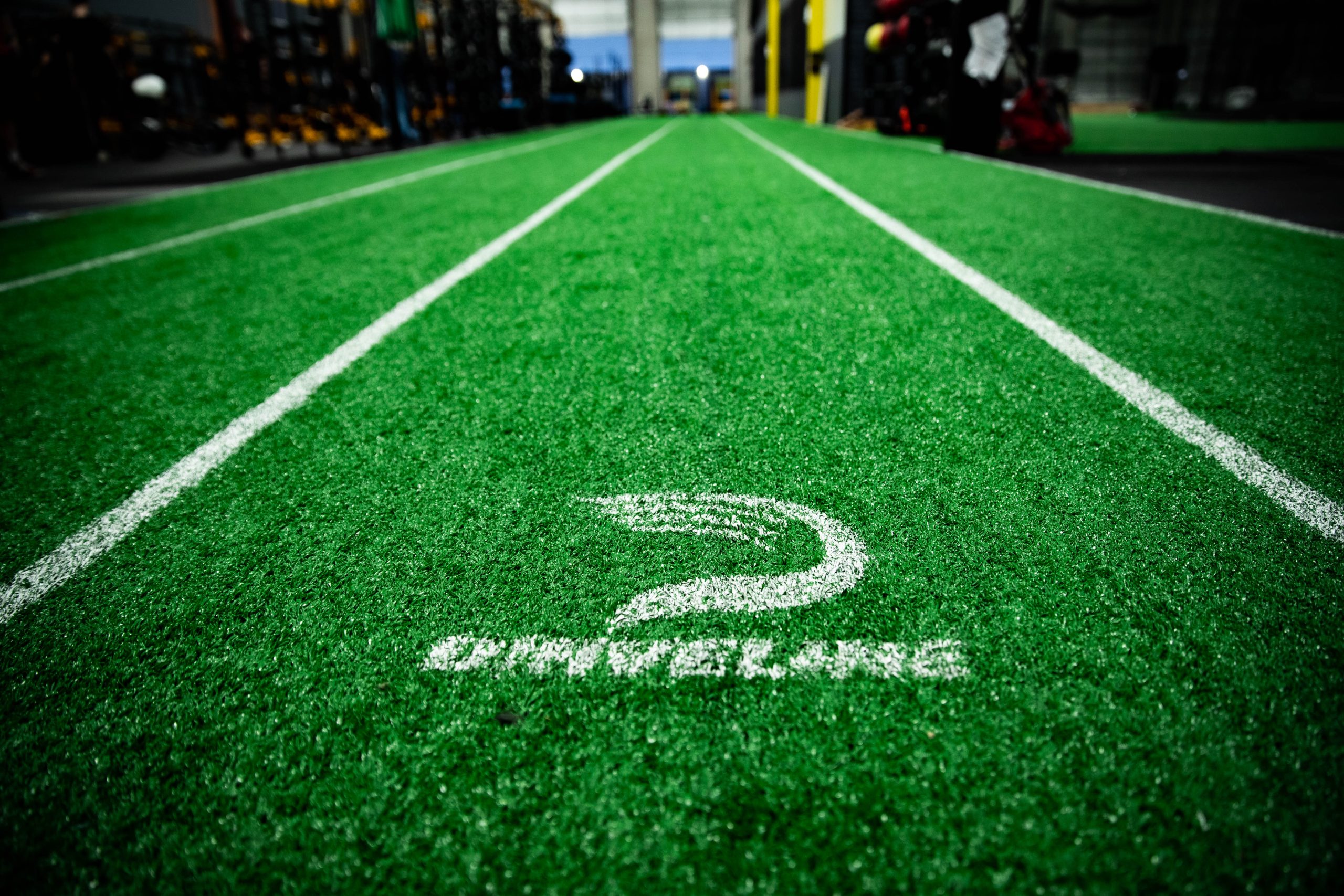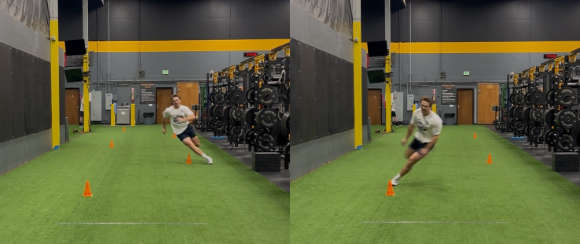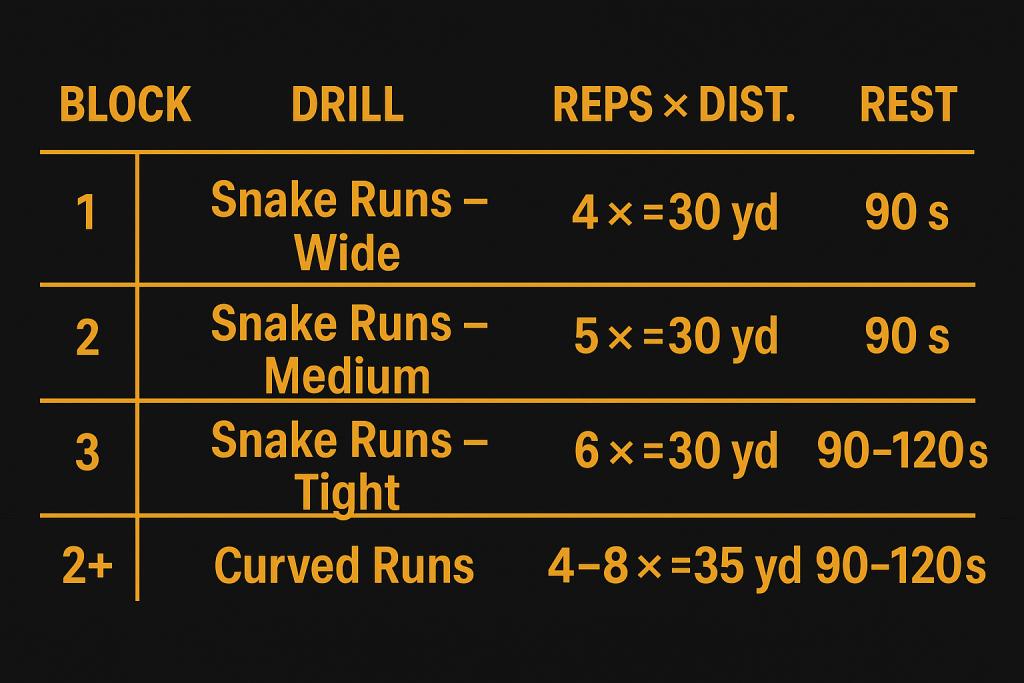Off‑Season Speed Training for Position Players – Part 3: Non‑Linear Running

Welcome to the third installment of our four‑part series on off‑season speed training for Minor League Baseball (MiLB) position players. In Part 1 we outlined the overall system, and in Part 2 we drilled down into acceleration. Now we turn to the second speed session of the week, held on Wednesdays, where we focus on movement transitions and non‑linear running.
Working Constraints
Typically Day 2 of speed training is reserved for top‑end velocity, but a wet Seattle winter and limited indoor turf made that unrealistic. Without enough runway to reach, hold, and safely decelerate from max speed, we shifted the goal to improving movement transitions and running in non‑linear patterns. Curved running would have shown up in the top‑speed day anyway later on in the off-season, so we simply introduced it earlier. The added turns also extend the distance traveled in each repetition, letting athletes cover more yardage than they could with straight sprints in our space.
Curved runs and snake routes provide a ton of benefit for position players as we approach the midpoint of the pro offseason—it’s time to start introducing more specificity so we can build it up over these next couple months and get them primed for spring training📈@DrivelineBB pic.twitter.com/TdfIFbj6og
— Jen Taft (@JTaft7) December 17, 2024
Why Train Non‑Linear Speed?
Non‑linear running is important for baseball players because they rarely run in straight lines. Performing speed work in patterns that mirror game movement helps prepare them to handle higher‑intensity cutting, get the lower limbs accustomed to non‑linear forces, and teach the body how to lean efficiently through turns.
Below, we can see how the athlete’s left lower limb adjusts to withstand non‑linear forces in both directions while rounding a turn.

Session Flow
- Dynamic warm‑up – standard movement prep
- Movement‑transition drills – switching among sprint, shuffle, and backpedal
- Single‑leg jump series – six land‑and‑stick hops
- Non‑linear runs – snake runs, curved runs, advanced curves
Rest 90–120 seconds between reps so each effort stays at full speed.
Movement‑Transition Drills
The warm‑up finishes with drills that force quick changes between gaits, priming the athletes for non-linear work.
Single‑Leg Jump Series
We start with forward‑facing land‑and‑stick jumps, then add rotational landings once the athletes are proficient.
Take off from two feet and land in this six‑position sequence:
- Right foot, facing forward
- Left foot, facing forward
- Right foot, facing right
- Left foot, facing right
- Right foot, facing left
- Left foot, facing left
Progression: Add a hop‑and‑stick after every landing.
Non‑Linear Running Progressions
Movement proficiency will increase with repetition, so we gradually progress the stimulus and movement complexity over time to drive adaptation. Our first non‑linear progression was snake runs, followed later by curved runs.
Tightened up the angles on snake runs and added a turn leading into the curved sprint.
— Jen Taft (@JTaft7) December 21, 2024
Introduce stimulus: what needs to be trained?
⤵️
Athletes adapt: movement proficiency improves with repetition
⤵️
Increase stimulus: gradually progress the movement complexity@DrivelineBB pic.twitter.com/ufKoHkgDsY
Snake Runs • Phase 1 – Wide Gates
During the first phase the cones marking each turn were set on the edges of the turf with roughly eight to ten yards between them. I never made the distance exact because I didn’t want reps to become robotic—having a little variance keeps the athletes sharp by forcing continual adjustments and keep from falling into an easy rhythm.
Snake Runs • Phase 2 – Medium Gates
For the next phase I moved the cones a few feet inward and had the athletes actually run around them instead of running up to the cone and making a cut like in Phase 1. At that point I didn’t want the turns to be any sharper, but there wasn’t enough room to go fully around the cones until they moved inward during Phase 2.
Snake Runs • Phase 3 – Tight Gates
Once we reached the final progression the cones were set almost in a straight line, creating the tightest turns yet. We opened each session with a couple of warm‑up reps at a moderate speed before going full tilt. The off‑season began with four total reps of snake runs and built up to six, each roughly thirty yards long. We took ninety seconds to two minutes of recovery after every rep because these runs are longer than our acceleration sprints and still need to be executed at one‑hundred‑percent effort.
Curved Runs
Our second non‑linear drill was curved runs, introduced during the second phase of the off‑season because I wanted the athletes to adjust to non‑linear running at lower intensities first. Just like the snake runs, the first rep in each direction was always below full speed so the athletes could feel out the turns. The cones were set in a half‑moon, giving enough runway to build to full speed before the curve and space afterward to slow down without slamming on the brakes. We performed two to four sprints in each direction—four to eight total—resting ninety seconds to two minutes between reps.
Advanced Curves
Later in the off‑season we added a turn into the lead‑up of the curved run—or at the end of the curve, depending on the direction. Now the athletes weren’t focused only on smoothly entering or exiting the curve; they had a new factor to adjust to. Even a small change in stimulus can help capture more of the adaptations we want. I never want the athletes to get too used to what we’re doing and become robotic—no matter how minor, novelty keeps them sharp.
Programming Snapshot

Distances vary slightly so the athletes cannot memorize the course.
Keeping Intensity High
Pairing athletes to compete against each other via chasing helps guarantee maximal effort. If mechanics or times fall off, it is typically a good marker to end the session.
Looking Ahead
Part 4 will dive into our change of direction session, blending deceleration, re‑acceleration, and field‑specific angles.
Comment section